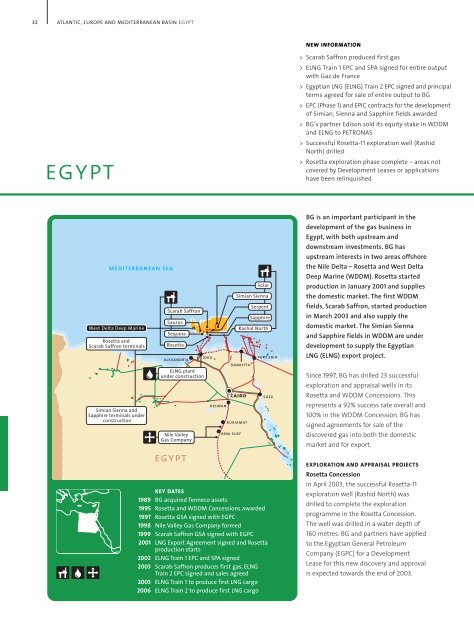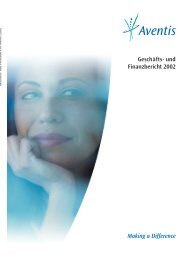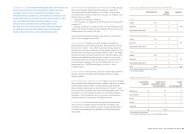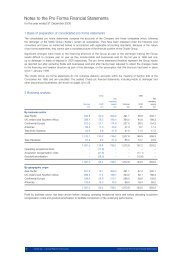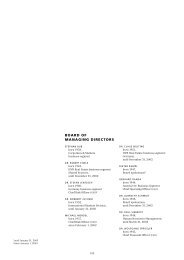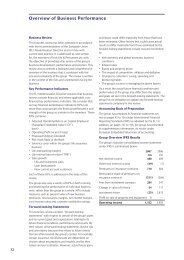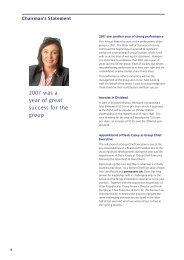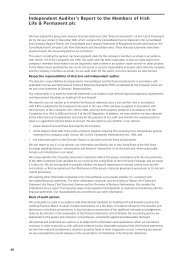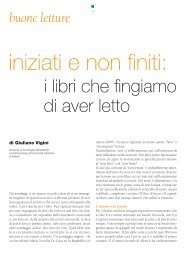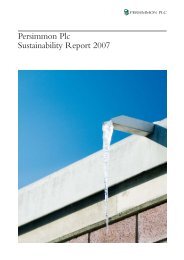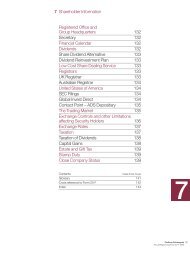Atlantic, Europe and Mediterranean Basin (441 kb) - Investis
Atlantic, Europe and Mediterranean Basin (441 kb) - Investis
Atlantic, Europe and Mediterranean Basin (441 kb) - Investis
You also want an ePaper? Increase the reach of your titles
YUMPU automatically turns print PDFs into web optimized ePapers that Google loves.
32 ATLANTIC, EUROPE AND MEDITERRANEAN BASIN EGYPT<br />
egypt<br />
mediterranean sea<br />
West Delta Deep Marine<br />
Rosetta <strong>and</strong><br />
Scarab Saffron terminals<br />
Simian Sienna <strong>and</strong><br />
Sapphire terminals under<br />
construction<br />
Scarab Saffron<br />
Saurus<br />
Sequoia<br />
Rosetta<br />
alex<strong>and</strong>ria<br />
ELNG plant<br />
under construction<br />
Nile Valley<br />
Gas Company<br />
egypt<br />
idku<br />
helwan<br />
damietta<br />
cairo<br />
kuriamat<br />
beni suef<br />
Solar<br />
Simian Sienna<br />
Serpent<br />
Sapphire<br />
Rashid North<br />
port said<br />
KEY DATES<br />
1989 BG acquired Tenneco assets<br />
1995 Rosetta <strong>and</strong> WDDM Concessions awarded<br />
1997 Rosetta GSA signed with EGPC<br />
1998 Nile Valley Gas Company formed<br />
1999 Scarab Saffron GSA signed with EGPC<br />
2001 LNG Export Agreement signed <strong>and</strong> Rosetta<br />
production starts<br />
2002 ELNG Train 1 EPC <strong>and</strong> SPA signed<br />
2003 Scarab Saffron produces first gas, ELNG<br />
Train 2 EPC signed <strong>and</strong> sales agreed<br />
2005 ELNG Train 1 to produce first LNG cargo<br />
2006 ELNG Train 2 to produce first LNG cargo<br />
suez<br />
NEW INFORMATION<br />
> Scarab Saffron produced first gas<br />
> ELNG Train 1 EPC <strong>and</strong> SPA signed for entire output<br />
with Gaz de France<br />
> Egyptian LNG (ELNG) Train 2 EPC signed <strong>and</strong> principal<br />
terms agreed for sale of entire output to BG<br />
> EPC (Phase 1) <strong>and</strong> EPIC contracts for the development<br />
of Simian, Sienna <strong>and</strong> Sapphire fields awarded<br />
> BG’s partner Edison sold its equity stake in WDDM<br />
<strong>and</strong> ELNG to PETRONAS<br />
> Successful Rosetta-11 exploration well (Rashid<br />
North) drilled<br />
> Rosetta exploration phase complete – areas not<br />
covered by Development Leases or applications<br />
have been relinquished<br />
BG is an important participant in the<br />
development of the gas business in<br />
Egypt, with both upstream <strong>and</strong><br />
downstream investments. BG has<br />
upstream interests in two areas offshore<br />
the Nile Delta – Rosetta <strong>and</strong> West Delta<br />
Deep Marine (WDDM). Rosetta started<br />
production in January 2001 <strong>and</strong> supplies<br />
the domestic market. The first WDDM<br />
fields, Scarab Saffron, started production<br />
in March 2003 <strong>and</strong> also supply the<br />
domestic market. The Simian Sienna<br />
<strong>and</strong> Sapphire fields in WDDM are under<br />
development to supply the Egyptian<br />
LNG (ELNG) export project.<br />
Since 1997, BG has drilled 23 successful<br />
exploration <strong>and</strong> appraisal wells in its<br />
Rosetta <strong>and</strong> WDDM Concessions. This<br />
represents a 92% success rate overall <strong>and</strong><br />
100% in the WDDM Concession. BG has<br />
signed agreements for sale of the<br />
discovered gas into both the domestic<br />
market <strong>and</strong> for export.<br />
EXPLORATION AND APPRAISAL PROJECTS<br />
Rosetta Concession<br />
In April 2003, the successful Rosetta-11<br />
exploration well (Rashid North) was<br />
drilled to complete the exploration<br />
programme in the Rosetta Concession.<br />
The well was drilled in a water depth of<br />
160 metres. BG <strong>and</strong> partners have applied<br />
to the Egyptian General Petroleum<br />
Company (EGPC) for a Development<br />
Lease for this new discovery <strong>and</strong> approval<br />
is expected towards the end of 2003.
50<br />
20<br />
40<br />
50<br />
40<br />
40<br />
Partners (%) Rosetta Concession<br />
BG (operator)<br />
40 Shell<br />
20 Edison International<br />
50<br />
Partners (%) WDDM Concession<br />
BG (operator)<br />
50 PETRONAS<br />
West Delta Deep Marine Concession<br />
(WDDM)<br />
Since the Concession was awarded in 1995,<br />
BG has drilled 16 successful exploration<br />
<strong>and</strong> appraisal wells in WDDM – a 100%<br />
success rate. BG has also conducted an<br />
extensive seismic acquisition programme<br />
– a total of 4 910 sq km of 3D seismic,<br />
together with 4 900 sq km of 2D seismic<br />
has been shot. In August 2002, 1 225 sq km<br />
of the 3D seismic was acquired <strong>and</strong><br />
evaluation of this data will form the<br />
basis of future exploration activity<br />
in the Concession.<br />
This exploration programme has resulted<br />
in the discovery of nine gas fields – Scarab,<br />
Saffron, Simian, Sienna, Sapphire, Serpent,<br />
Saurus, Sequoia <strong>and</strong> Solar. The Sapphire<br />
field also contains significant quantities<br />
of condensate. The Sapphire-1 well, drilled<br />
in July 2000, flowed at 35 mmscfd of gas<br />
<strong>and</strong> 1 100 bbls of condensate per day. In<br />
December 2000, the Sapphire-2 appraisal<br />
well confirmed the presence of<br />
significant volumes of condensate in the<br />
Sapphire accumulation. In 2001, a further<br />
successful appraisal well, Sapphire-3<br />
was drilled, confirming the largest gas<br />
column recorded to date in Egypt.<br />
A new discovery in 2002, the Solar field,<br />
<strong>and</strong> two further successful appraisal<br />
wells underlined the prolific nature of the<br />
WDDM Concession. The Solar-1 well was<br />
completed in January 2002 after being<br />
drilled in 1 046 metres of water. The<br />
Sapphire-4 well, drilled in a water depth<br />
of 488 metres, confirmed the north-east<br />
extension of the Sapphire field. In April<br />
2002, the Sienna-2 well, drilled in a water<br />
depth of 991 metres, confirmed the<br />
extent of the Sienna field. This well<br />
marked the completion of the latest<br />
appraisal programme <strong>and</strong> confirmed<br />
sufficient reserves to underpin the<br />
marketing of ELNG Train 2. With the<br />
exception of Solar, all WDDM discoveries<br />
to date have been captured in<br />
Development Leases.<br />
In April 2003, BG’s partner in WDDM,<br />
Edison International, announced the sale<br />
of its 50% interest in the Concession to<br />
the Malaysian oil <strong>and</strong> gas company<br />
PETRONAS. The sale completed in June<br />
2003 <strong>and</strong> was effective from 1 January<br />
2003. BG remains the Concession operator.<br />
UPSTREAM DEVELOPMENT PROJECTS<br />
Rosetta<br />
BG <strong>and</strong> its partners, Shell <strong>and</strong> Edison<br />
International, signed a 25 year Gas Sales<br />
Agreement (GSA) in October 1997 with<br />
EGPC, to supply gas from the Rosetta<br />
Concession into the domestic market.<br />
EGPC received first gas from Rosetta on<br />
31 January 2001, just 45 months from first<br />
discovery in April 1997. The initial stage<br />
of the Rosetta development consists of<br />
six wells tied back to a ‘not normally<br />
manned’ platform with a 66 km gas <strong>and</strong><br />
condensate pipeline to the onshore<br />
terminal, for delivery into the national<br />
grid system near Idku, east of Alex<strong>and</strong>ria.<br />
A joint venture company, Rashid Petroleum<br />
Company, conducts operations on behalf<br />
of the Rosetta partners <strong>and</strong> EGPC.<br />
Since the Rosetta Concession award in<br />
1995, BG has undertaken gross capital<br />
20<br />
25<br />
10<br />
50<br />
50<br />
20<br />
25<br />
ATLANTIC, EUROPE AND MEDITERRANEAN BASIN EGYPT 33<br />
20<br />
Partners (%) Rashid Petroleum Company<br />
BG<br />
50 EGPC<br />
20 Shell<br />
10 Edison International<br />
25<br />
Partners (%) Burullus Gas Company<br />
BG<br />
50 EGPC<br />
25 PETRONAS<br />
expenditure of $314 million to realise the<br />
first phase of development. During 2002,<br />
Rosetta produced a total of 99.1 bcf of<br />
gas (21.6 bcf net BG). Rosetta has shown<br />
that it is capable of producing up to<br />
335 mmscfd, well above its Daily Contract<br />
Quantity (DCQ) of 275 mmscfd. It has<br />
continued to prove a flexible <strong>and</strong> reliable<br />
source of gas to the Egyptian domestic<br />
market <strong>and</strong> has been able to realise<br />
opportunities to produce above the DCQ<br />
during periods of high dem<strong>and</strong>. This<br />
helped Rosetta achieve an average rate<br />
above the 75% of the Annual Contract<br />
Quantity (ACQ) minimum contractual<br />
take level in 2002.<br />
Phase 2 of the Rosetta development<br />
will consist of an unmanned minimum<br />
facilities wellhead platform tied back to<br />
the existing Rosetta platform. The project<br />
FEED work started in March 2003 <strong>and</strong><br />
first gas from the project is scheduled<br />
for the fourth quarter of 2005.<br />
Scarab Saffron<br />
Delivery of first gas from the Scarab<br />
Saffron development occurred on<br />
29 March 2003. Scarab Saffron supplies<br />
gas to the domestic market under a<br />
GSA signed in August 1999 with EGPC.<br />
Under an amendment to the GSA signed<br />
in December 2002, the initial DCQ will<br />
be 440 mmscfd upon completion of the<br />
90 day run in period. On 1 January 2004,<br />
the DCQ will rise to 586 mmscfd for one<br />
year <strong>and</strong> then will rise again at the start<br />
of 2005 to 626 mmscfd. On 1 January<br />
2006, the DCQ will decrease to 533 mmscfd<br />
unless three months have already
34 ATLANTIC, EUROPE AND MEDITERRANEAN BASIN EGYPT<br />
12<br />
12<br />
12<br />
12<br />
38<br />
5<br />
35.5<br />
35.5<br />
38<br />
egypt continued<br />
elapsed since the first shipment from<br />
ELNG, as the DCQ will then rise an<br />
additional 100 mmscfd to 633 mmscfd<br />
for seven years.<br />
The Scarab Saffron fields are larger <strong>and</strong><br />
in deeper water (in excess of 700 metres)<br />
than any other gas fields so far developed<br />
in Egypt <strong>and</strong> are the first to be developed<br />
using sub-sea completion technology.<br />
The Scarab Saffron development consists<br />
of eight sub-sea wells tied into a pipeline<br />
end manifold that is in turn tied back to<br />
an onshore terminal by two gas pipelines<br />
– 36-inch <strong>and</strong> 24-inch export pipelines.<br />
This additional pipeline capacity has<br />
been installed to allow subsequent field<br />
developments to tie into the Scarab<br />
Saffron facilities. Field operations are<br />
controlled from the onshore terminal via<br />
electrical <strong>and</strong> hydraulic umbilical lines.<br />
Burullus Gas Company, a joint venture<br />
company consisting of BG, EGPC <strong>and</strong><br />
PETRONAS, is undertaking exploration<br />
<strong>and</strong> field development operations on<br />
behalf of the WDDM Concession holders.<br />
Export Development Projects<br />
In April 2001, a fully termed agreement<br />
was signed with EGPC, setting the<br />
commercial foundation for the<br />
development of a LNG export project.<br />
The agreement includes amendments<br />
to the existing WDDM Concession<br />
Agreement <strong>and</strong> the GSA. The Egyptian<br />
People’s Assembly ratified the amended<br />
Concession Agreement in March 2002.<br />
Shareholders (%) ELNG Holding,<br />
Operating <strong>and</strong> Train 1 Companies<br />
35.5 BG<br />
35.5 PETRONAS<br />
12 EGPC<br />
12 Egyptian Natural Gas Holding Company (EGAS)<br />
5 Gaz de France<br />
38<br />
Shareholders (%) in ELNG Train 2 Company<br />
BG<br />
38 PETRONAS<br />
12 EGPC<br />
12 EGAS<br />
BG <strong>and</strong> its partner are therefore the first,<br />
<strong>and</strong> currently only, upstream players in<br />
Egypt with a definitive export agreement<br />
allowing the export of gas from a<br />
development within a concession area.<br />
The amendments to the WDDM<br />
Concession Agreement also introduced<br />
a floor <strong>and</strong> ceiling price to domestic gas<br />
sales. At Brent oil prices below $10/bbl,<br />
the floor price payable for domestic gas<br />
is $1.50/mmbtu <strong>and</strong> a ceiling price of<br />
$2.65/mmbtu applies when Brent is<br />
above $20/bbl. This pricing arrangement<br />
was adopted simultaneously for the<br />
Rosetta Development Leases <strong>and</strong> has<br />
been adhered to since production on<br />
Rosetta commenced.<br />
As part of the Scarab Saffron<br />
development, sufficiently large offshore<br />
pipelines have been installed to support<br />
a two-train LNG development, in addition<br />
to supplies to the domestic market from<br />
the Scarab Saffron fields.<br />
Simian Sienna <strong>and</strong> Sapphire<br />
The Simian Sienna fields are being<br />
developed to supply gas to Train 1 of the<br />
ELNG export project whilst the Sapphire<br />
field will supply Train 2. Development of<br />
the Simian Sienna <strong>and</strong> Sapphire fields<br />
will be integrated with the Scarab<br />
Saffron fields to maximise synergies<br />
<strong>and</strong> reduce development costs through<br />
st<strong>and</strong>ardisation of equipment <strong>and</strong><br />
optimising facilities capacity. Like the<br />
Scarab Saffron project, they will use<br />
sub-sea completion technology but due<br />
to the increased step-out from the shore,<br />
the project will utilise a shallow water<br />
controls platform to reduce controls system<br />
risks <strong>and</strong> maintain plant availability. EPIC<br />
20<br />
5<br />
37.5<br />
37.5<br />
Shareholders (%) NVGC<br />
37.5 BG<br />
37.5 Edison International<br />
20 Orascom<br />
5 Middle East Gas Association<br />
<strong>and</strong> EPC contracts have been awarded<br />
to develop the offshore <strong>and</strong> onshore<br />
facilities for the three fields.<br />
DOWNSTREAM PROJECTS<br />
Egyptian LNG (ELNG)<br />
The ELNG Train 1 <strong>and</strong> Train 2 plants <strong>and</strong><br />
common facilities are under construction<br />
in their own Tax Free Zone near Idku.<br />
The zone is adjacent to the Rosetta <strong>and</strong><br />
Scarab Saffron facilities where gas from<br />
BG’s fields enters the Egyptian national<br />
gas transmission system. The $1.35 billion<br />
first train is designed to produce 3.6 mtpa<br />
of LNG <strong>and</strong> the second train is expected<br />
to double the plant’s capacity. The<br />
two-train development is expected to<br />
cost approximately $1.9 billion. Both trains<br />
will be built using the Phillips liquefaction<br />
technology <strong>and</strong> they will share storage<br />
<strong>and</strong> marine facilities. The site can<br />
accommodate up to six LNG trains <strong>and</strong><br />
a multiple company structure has been<br />
selected by the sponsors to give<br />
maximum flexibility for future expansions.<br />
It is designed to allow other gas producers<br />
in Egypt to invest in future LNG export<br />
gas trains, without having to replicate<br />
supporting infrastructure. Additionally,<br />
it is intended to make future expansions<br />
of the ELNG project easier to finance.<br />
The ELNG Holding Company will own<br />
both the ELNG site <strong>and</strong> common facilities,<br />
such as storage tanks <strong>and</strong> jetty. An<br />
operating company will undertake<br />
operations of all trains, although separate<br />
companies will own the individual trains.<br />
The ELNG Train 1 Company will borrow<br />
the required funds <strong>and</strong> build <strong>and</strong> own
Train 1. The ELNG Train 2 Company is in<br />
the process of being formed <strong>and</strong> will do<br />
the same in relation to Train 2.<br />
Following a Heads of Terms agreement<br />
signed in January 2002, a LNG Sale <strong>and</strong><br />
Purchase Agreement was signed in<br />
October 2002 for the sale of the entire<br />
output of the 3.6 mtpa first train to Gaz<br />
de France. Train 1 is scheduled to start<br />
production in the second half of 2005.<br />
In parallel to the commercial framework,<br />
construction of Train 1 <strong>and</strong> the common<br />
facilities started with an early works<br />
programme in May 2002 <strong>and</strong> the full<br />
EPC contract with Bechtel was signed in<br />
September 2002. BG <strong>and</strong> its partners also<br />
made progress securing project finance<br />
of $1.15 billion for the construction of<br />
Train 1 <strong>and</strong> common facilities with the<br />
announcement in January 2003 of the<br />
appointment of 12 international <strong>and</strong><br />
three Egyptian banks as International<br />
<strong>and</strong> Egyptian M<strong>and</strong>ated Lead Arrangers<br />
respectively.<br />
At the same time as purchasing Edison’s<br />
stake in the WDDM Concession, PETRONAS<br />
also purchased its stake in the ELNG<br />
project in June 2003.<br />
Construction of Train 2 started in<br />
May 2003. Early works commenced in<br />
December 2002. In June 2003, BG <strong>and</strong> its<br />
partners agreed principal terms for the<br />
sale of the whole of Train 2 output to BG<br />
Gas Marketing, a subsidiary of BG Group.<br />
At the same time, the ELNG partners<br />
signed the full EPC contract for Train 2 with<br />
Bechtel. Train 2 is expected to start LNG<br />
production in mid 2006. For approximately<br />
the first year of production, the entire<br />
output is intended to supply the Lake<br />
Charles LNG import terminal in Louisiana,<br />
USA. After that time, Train 2 volumes<br />
can be switched to supply the proposed<br />
LNG import terminal at Brindisi, Italy,<br />
which is being developed by BG <strong>and</strong><br />
Enel (see page 39).<br />
Nile Valley Gas Company (NVGC)<br />
In 1998, BG <strong>and</strong> its partners signed a<br />
25 year franchise agreement with EGPC<br />
for the exclusive right to develop the<br />
gas market in Upper Egypt. Formed in<br />
September 1998 with BG as the lead<br />
participant, the Nile Valley Gas Company<br />
(NVGC) is undertaking development of<br />
the gas market <strong>and</strong> infrastructure in<br />
Upper Egypt, focusing around Beni Suef.<br />
Phase 1, costing $38 million, has extended<br />
the gas transmission network from south<br />
of Kuriamat to Beni Suef, with first gas<br />
deliveries achieved in March 1999. During<br />
Phase 1, NVGC contracted with over<br />
17 000 domestic customers <strong>and</strong> a number<br />
of major industrial users.<br />
Further information on the Nile Valley<br />
Gas Company can be found on its<br />
website, www.nilevalleygasco.com<br />
ATLANTIC, EUROPE AND MEDITERRANEAN BASIN EGYPT 35<br />
800<br />
600<br />
400<br />
200<br />
0<br />
Scarab Saffron DCQ<br />
(mmscfd)<br />
Until<br />
end 03<br />
1 Jan<br />
04<br />
1 Jan<br />
05<br />
1 Jan*<br />
06<br />
* DCQ of 533 mmscfd unless 3 months have elapsed since first<br />
ELNG shipment – will then be 633 mmscfd for 7 years<br />
NOTES
36 ATLANTIC, EUROPE AND MEDITERRANEAN BASIN ISRAEL AND AREAS OF PALESTINIAN AUTHORITY<br />
israel <strong>and</strong><br />
areas of palestinian<br />
authority<br />
Matan (309 – Block Gal B)<br />
Michal (308 – Block Gal A)<br />
mediterranean sea<br />
Offshore Gaza<br />
Gaza Marine<br />
egypt<br />
Or<br />
Med Yavne<br />
lebanon<br />
israel<br />
gaza<br />
KEY DATES<br />
1999 BG acquired the Gal preliminary permits,<br />
Med licences <strong>and</strong> offshore Gaza licence<br />
Or gas discovery<br />
2000 3D seismic shot over the offshore Gaza <strong>and</strong><br />
Med licences<br />
Gaza Marine gas discovery<br />
2001 3D seismic shot over the Gal licences<br />
2002 Additional 2D seismic shot over the offshore<br />
Gaza licence<br />
NEW INFORMATION<br />
> Following the withdrawal of various partners<br />
from the Gal Licences, BG <strong>and</strong> the other<br />
continuing parties are actively seeking a<br />
new partner<br />
> Offshore Gaza exploration well deferred<br />
until 2004 pending the successful<br />
commercialisation of the Gaza Marine field<br />
BG has been active in the region since<br />
1999 <strong>and</strong> current activities are focused<br />
upon the successful commercialisation<br />
of its offshore gas discoveries, led by the<br />
largest reservoir Gaza Marine. Gas sales<br />
negotiations with major power <strong>and</strong><br />
industrial users in Israel are being<br />
pursued, whilst on the downstream side<br />
BG is lending its expertise to assist in<br />
the establishment of gas infrastructure<br />
across Israel <strong>and</strong> the Areas of<br />
Palestinian Authority.<br />
ISRAEL<br />
Med Yavne Lease<br />
BG rationalised its interests in the Med<br />
licences in 2002, following the earlier<br />
acquisition, processing <strong>and</strong> interpretation<br />
of seismic data. BG retains operatorship<br />
of the Med Yavne lease, which was<br />
reduced to an area of 52.3 sq km around<br />
the Or gas discovery made in 1999.<br />
Gal Licences<br />
BG is operator of two offshore<br />
exploration blocks, Matan <strong>and</strong> Michal.<br />
Early in 2003, IPE <strong>and</strong> Granit-Sonol<br />
withdrew from the licences <strong>and</strong> other<br />
partners reduced their interest.<br />
Consequently, the continuing parties<br />
are actively seeking a new partner to<br />
participate in the licences, including the<br />
planned deep water 1 600m exploration<br />
well on the Matan licence.
13.2<br />
39.8<br />
1.8<br />
8.0<br />
5<br />
42.0<br />
6<br />
35.0<br />
25<br />
19.2<br />
AREAS OF THE PALESTINIAN AUTHORITY<br />
Offshore Gaza<br />
5<br />
35.0<br />
Partners (%) Med Yavne<br />
BG (operator)<br />
42.0 Isramco Group<br />
13.2 Middle East Energy<br />
8.0 Delek Drilling Limited<br />
1.8 Dor Gas<br />
25.0<br />
Partners (%) Matan <strong>and</strong> Michal<br />
BG (operator)<br />
5.0 Isramco Group<br />
19.2 Middle East Energy<br />
6.0 STX (2000)<br />
5.0 Dor Gas<br />
39.8 Unallocated<br />
Following acquisition of over 1 000 sq km<br />
of 3D seismic data, BG drilled two<br />
successful wells in the second half of<br />
2000 (Gaza Marine-1 <strong>and</strong> Gaza Marine-2).<br />
The first of these tested 37 mmscfd of<br />
gas on a 48/64" choke with the flow rate<br />
constrained by testing equipment. The<br />
second well was not tested but confirmed<br />
a major gas discovery in the Gaza Marine<br />
field. In 2001, a major technical review<br />
recommended development via sub-sea<br />
wells <strong>and</strong> a pipeline to an onshore<br />
processing terminal, incorporating similar<br />
technologies to BG’s Scarab Saffron<br />
development offshore Egypt.<br />
During November <strong>and</strong> December 2002,<br />
BG acquired an additional 925 km of 2D<br />
seismic data in order to better evaluate<br />
the area between the existing discoveries<br />
<strong>and</strong> the shore. The offshore Gaza<br />
exploration well that was planned for<br />
2003 has now been deferred until 2004,<br />
pending the successful commercialisation<br />
of the Gaza Marine field. BG currently<br />
holds 90% equity in the licence, which<br />
will be reduced to 60% after<br />
Consolidated Contractors Company<br />
<strong>and</strong> the Palestine Investment Fund<br />
exercise their options.<br />
ATLANTIC, EUROPE AND MEDITERRANEAN BASIN ISRAEL AND AREAS OF PALESTINIAN AUTHORITY 37<br />
10<br />
90<br />
90<br />
Partners (%) Offshore Gaza<br />
BG (operator)<br />
10 Consolidated Contractors Company<br />
NOTES
38 ATLANTIC, EUROPE AND MEDITERRANEAN BASIN ITALY<br />
italy<br />
turin<br />
rivalta<br />
mediterranean sea<br />
tunisia<br />
milan<br />
italy<br />
rome<br />
tyrrhenian sea<br />
P<strong>and</strong>a<br />
sulmona<br />
cassino<br />
naples<br />
slovenia<br />
adriatic sea<br />
termoli<br />
croatia<br />
hungary<br />
bosnia &<br />
herzegovina<br />
Proposed LNG terminal<br />
melfi<br />
brindisi<br />
ionian sea<br />
KEY DATES<br />
1992 BG commenced activities in Italy<br />
1998 SERENE power stations began operation<br />
2003 All major construction <strong>and</strong> operational<br />
authorisations granted for Brindisi LNG Terminal<br />
2004 First BG-operated well planned for the Po Valley<br />
Brindisi LNG plant construction to begin<br />
2007 First LNG imports to Brindisi to begin<br />
NEW INFORMATION<br />
> BG granted authorisation to build a LNG<br />
terminal at Brindisi<br />
> BG signed for exclusive use of the Brindisi Port<br />
area where the terminal will be built<br />
> In May 2003, BG sold a 50% stake in the Brindisi<br />
LNG development project to Enel<br />
> Part of Brindisi supply intended to come from<br />
Egyptian LNG Train 2<br />
Active in Italy since 1992, BG is further<br />
developing its gas chain capability. Italy<br />
is a net importer of gas, a commodity<br />
upon which it is becoming increasingly<br />
dependent as the government focuses<br />
on environmentally friendly energy<br />
sources. BG is positioning itself within<br />
the Italian market to help satisfy the<br />
rise in dem<strong>and</strong>.<br />
Current BG activity in Italy includes: E&P,<br />
where BG holds 12 exploration permits;<br />
Power, through a partnership that<br />
operates five power plants; <strong>and</strong> LNG,<br />
where BG is developing a LNG import<br />
terminal on the south-eastern coast.<br />
Exploration <strong>and</strong> Production<br />
BG has refocused its Italian exploration<br />
<strong>and</strong> production on high potential oil <strong>and</strong><br />
gas exploration acreage in the Sicily<br />
Channel <strong>and</strong> the Po Valley. The portfolio<br />
consists of 12 exploration permits, six of<br />
which are operated by BG.<br />
In April 2002, BG announced a gas<br />
discovery in the Sicily Channel drilled on<br />
the P<strong>and</strong>a exploration prospect where<br />
BG has a 37.5% interest. An appraisal<br />
programme comprising the P<strong>and</strong>a West-1<br />
well, drilled in early 2003, <strong>and</strong> a 3D<br />
seismic survey, to be acquired in early<br />
2004, is intended to prove the<br />
commerciality of the discovery.<br />
A three year onshore exploration<br />
programme is underway in the Po Valley<br />
with a 2003 seismic acquisition<br />
programme. The first well is scheduled<br />
to be drilled on the high pressure/high<br />
temperature Cascina Favorita-1 prospect,
32<br />
1.6<br />
3.2<br />
5<br />
63<br />
3.2<br />
Shareholders (%) SERENE S.p.A<br />
63 Edison<br />
32 BG<br />
5 NHS (subsidiary of Banca San Paolo – IMI)<br />
located around 40 km to the south-west<br />
of Milan. The first operated well is<br />
planned for 2004, subject to the granting<br />
of environmental approvals.<br />
Power Generation<br />
BG is a partner in SERENE S.p.A, a joint<br />
venture company that owns <strong>and</strong><br />
operates approximately 400 MW of<br />
co-generation at five locations adjacent<br />
to Fiat Auto factories. The 100 MW power<br />
stations are located at Melfi, Termoli <strong>and</strong><br />
Cassino with the 50 MW stations at both<br />
Sulmona <strong>and</strong> Rivalta. The plants have<br />
been in operation for six years <strong>and</strong> are<br />
located to allow steam supply to Fiat<br />
Auto plants.<br />
SERENE supplies nearly 3 000 GWh per<br />
year of electricity to the grid operator,<br />
GRTN, <strong>and</strong> 320 000 tons of steam to Fiat.<br />
BG is co-developer of the project <strong>and</strong> has<br />
a 32% interest in the company. Fuel gas is<br />
supplied to the plants by Eni <strong>and</strong> Edison.<br />
The total investment in SERENE<br />
is £260 million, of which financing<br />
arrangements for approximately<br />
£210 million were concluded in July 1998.<br />
2007 – Expected Capacity Rights in Brindisi<br />
LNG Terminal – bcma<br />
3.2 BG<br />
3.2 Enel<br />
1.6 Regulated third party access<br />
LNG<br />
BG is developing an 8 bcmpa (6 mtpa)<br />
LNG terminal at the outer harbour of the<br />
port of Brindisi, on the south-east coast<br />
of Italy.<br />
In January 2003, BG was granted an<br />
authorisation decree by the Ministry of<br />
Productive Activities, in agreement with<br />
the Ministry of Environment <strong>and</strong> the<br />
Puglia region, to build the Brindisi<br />
terminal. In February 2003, BG signed<br />
an Agreement in Lieu of Concession with<br />
the Brindisi Port Authority, which gives<br />
BG the exclusive right to use the port<br />
area in which the terminal will be built.<br />
In May 2003, BG signed a Share Sale <strong>and</strong><br />
Purchase Agreement with Enel for them<br />
to buy 50% of the Brindisi LNG project, <strong>and</strong><br />
a Project Development <strong>and</strong> Shareholders<br />
Agreement for the joint development.<br />
The FEED contract was awarded in June<br />
2003, <strong>and</strong> construction is expected to<br />
commence in early 2004, with first imports<br />
into the Italian market expected to start<br />
in 2007. Financial advisors for project<br />
financing were appointed in July 2003.<br />
BG <strong>and</strong> Enel equally share the 80%<br />
reserved capacity in the terminal, whilst<br />
the remaining 20% will be subject to<br />
regulated third-party access. The<br />
terminal is strategically located to receive<br />
LNG from the <strong>Mediterranean</strong> <strong>Basin</strong> <strong>and</strong><br />
the Gulf States.<br />
ATLANTIC, EUROPE AND MEDITERRANEAN BASIN ITALY 39<br />
NOTES
40 ATLANTIC, EUROPE AND MEDITERRANEAN BASIN SPAIN<br />
spain<br />
madrid<br />
spain<br />
Aguila<br />
Cormorán<br />
valencia<br />
france<br />
barcelona<br />
Ibis<br />
Halcón<br />
Flamenco Garceta<br />
Gorrión<br />
mediterranean sea<br />
balearic<br />
isl<strong>and</strong>s<br />
algeria<br />
KEY DATES<br />
2002 Seven exploration licences granted to BG<br />
Acquired 2 500 sq km of 3D seismic data<br />
2004 Drilling programme to begin<br />
algiers<br />
NEW INFORMATION<br />
> Technical evaluation of the 2 500 sq km of<br />
3D seismic data acquired in July 2002 is near<br />
completion<br />
> Preparation has begun for BG’s first exploration<br />
well in Spain which is expected to be spudded<br />
mid-2004<br />
BG is developing its interests in Spain,<br />
with an emphasis on building gas chain<br />
opportunities. Presently, BG is focused<br />
on evaluating its offshore exploration<br />
licences. Spain is a net importer of gas,<br />
is an EU member, <strong>and</strong> has a growing<br />
developed economy. These factors make<br />
investment in the country attractive<br />
to BG.<br />
Upstream Licences<br />
BG operates seven exploration licences<br />
offshore Spain, covering an area of<br />
6 500 sq km. The acreage is located in<br />
the Gulf of Valencia, 90 km north-east<br />
of Valencia <strong>and</strong> 100 km south-west<br />
of Barcelona.<br />
BG acquired 2 500 sq km of 3D seismic<br />
data in July 2002. The technical<br />
evaluation of this data is near completion.<br />
The drilling programme is expected to<br />
start in the middle of 2004. Any gas or<br />
oil discoveries will be developed for the<br />
Spanish domestic market. BG Group holds<br />
100% equity in all seven new licences.
trinidad <strong>and</strong> tobago<br />
Poinsettia<br />
Chaconia<br />
Hibiscus<br />
gulf of<br />
paria<br />
<strong>Atlantic</strong> LNG<br />
venezuela<br />
port of<br />
spain<br />
point<br />
lisas<br />
point<br />
fortin<br />
NCMA<br />
caribbean sea<br />
trinidad<br />
picton<br />
arima<br />
phoenix park<br />
galeota<br />
point<br />
KEY DATES<br />
1989 BG began operations in Trinidad <strong>and</strong> Tobago<br />
1996 BG <strong>and</strong> partner commenced production of the<br />
Dolphin gas field<br />
1999 US$1 billion ALNG Train 1 plant constructed<br />
at Point Fortin<br />
2001 Hibiscus platform installed<br />
2002 ALNG Train 2 started operation<br />
2003 ALNG Train 3 started operation<br />
Government approval for construction<br />
of ALNG Train 4<br />
2006 ALNG Train 4 to begin operation<br />
ATLANTIC, EUROPE AND MEDITERRANEAN BASIN TRINIDAD AND TOBAGO 41<br />
tobago<br />
Block E<br />
atlantic ocean<br />
Block 3(a)<br />
Angostura<br />
ECMA<br />
Starfish<br />
Block 5(a)<br />
Dolphin<br />
Block 6(b) Dolphin Deep<br />
Block 6(d)<br />
NEW INFORMATION<br />
> ALNG Train 3 started LNG production in April 2003<br />
> Government approved construction of ALNG Train 4<br />
> Ixora prospect drilled <strong>and</strong> successfully completed<br />
as part of the NCMA Development in July 2003<br />
> BG <strong>and</strong> partners signed the Joint Operating<br />
Agreement (JOA) for Block 3(a)<br />
> BG <strong>and</strong> partners expect to spud the first<br />
exploration well in Block 3(a) in 2003<br />
> BGTT retained ISO 14001 environmental certification<br />
BG Trinidad <strong>and</strong> Tobago, operating since<br />
1989, continues to reinforce its position as<br />
a major gas player in Trinidad <strong>and</strong> Tobago.<br />
BG currently supplies gas into the<br />
domestic market from the Dolphin field<br />
in the East Coast Marine Area (ECMA),<br />
<strong>and</strong> into <strong>Atlantic</strong> LNG for subsequent<br />
export to North America <strong>and</strong> <strong>Europe</strong>,<br />
from the North Coast Marine Area<br />
(NCMA) fields. BG has consistently<br />
proven the integrity of its upstream<br />
production facilities, regularly producing<br />
in excess of 800 mmscfd.<br />
BG continues to invest further in LNG<br />
expansion <strong>and</strong> seeks to create <strong>and</strong><br />
develop upstream opportunities to<br />
supply its capacity in <strong>Atlantic</strong> LNG.<br />
EAST COAST MARINE AREA<br />
Dolphin Platform<br />
The BG-operated Dolphin gas field, in a<br />
50/50 partnership with ChevronTexaco,<br />
commenced production in March 1996.<br />
The eight leg gas production platform<br />
is located 52 miles off the east coast of<br />
Trinidad in Block 6(b).<br />
The Dolphin field is contracted to supply<br />
up to 275 mmscfd of gas to the National<br />
Gas Company of Trinidad <strong>and</strong> Tobago<br />
under a 20 year supply contract.<br />
Development Activity in the ECMA<br />
In 2002, BG <strong>and</strong> partner ChevronTexaco<br />
received approval from the Government<br />
of Trinidad <strong>and</strong> Tobago for development<br />
of the Dolphin Deep field in Block 5(a)<br />
<strong>and</strong> the Starfish field which straddles<br />
Block 5(a) <strong>and</strong> Block E. Reserves from
42 ATLANTIC, EUROPE AND MEDITERRANEAN BASIN TRINIDAD AND TOBAGO<br />
30<br />
50<br />
10<br />
30<br />
50<br />
30<br />
50<br />
Shareholders (%) Dolphin – ECMA<br />
BG (operator)<br />
50 ChevronTexaco<br />
30<br />
Partners (%) Block 3(a)<br />
BG<br />
30 BHP (operator)<br />
30 Talisman<br />
10 Total<br />
trinidad <strong>and</strong> tobago continued<br />
these discoveries are to be produced<br />
through the upgraded Dolphin facilities<br />
via sub-sea completions <strong>and</strong> pipelines<br />
to supply gas to <strong>Atlantic</strong> LNG at Point<br />
Fortin. These completions will be the first<br />
sub-sea development in Trinidad <strong>and</strong><br />
Tobago waters to date. The Dolphin Deep<br />
Development project is scheduled to<br />
be completed in July 2005 to supply<br />
80 mmscfd to <strong>Atlantic</strong> LNG Train 3.<br />
Exploration/Appraisal Activity<br />
In April 2002, BG <strong>and</strong> partners signed<br />
a PSC with the Government of Trinidad<br />
<strong>and</strong> Tobago for Block 3(a). The 614 sq km<br />
block is located 40 km off the east coast<br />
of Trinidad in water depths of 30-90<br />
metres. The block is adjacent to Block 2(c)<br />
where BHP <strong>and</strong> partners have recently<br />
made significant gas <strong>and</strong> oil discoveries.<br />
Under the Block 3(a) PSC terms, BG <strong>and</strong><br />
partners have agreed to acquire 300 sq<br />
km of 3D seismic data <strong>and</strong> embark on a<br />
six well exploratory drilling programme.<br />
One year later, in April 2003, BG <strong>and</strong><br />
partners signed the Joint Operating<br />
Agreement (JOA) for Block 3(a). The<br />
completion of the negotiation of the<br />
JOA marked an important milestone<br />
for the partnership.<br />
NORTH COAST MARINE AREA<br />
Hibiscus Platform<br />
The BG-operated NCMA, located 40 km<br />
off the north coast of Trinidad, includes<br />
three gas fields – Hibiscus, Poinsettia<br />
<strong>and</strong> Chaconia.<br />
17.31<br />
In April 2000, a Unitisation Agreement<br />
was signed, <strong>and</strong> in December 2000 the<br />
Government of Trinidad <strong>and</strong> Tobago<br />
approved the development of the three<br />
fields. These fields are being developed<br />
in up to four phases to supply gas to the<br />
<strong>Atlantic</strong> LNG Trains 2 <strong>and</strong> 3 expansion.<br />
The Hibiscus platform was successfully<br />
installed in September 2001, in a water<br />
depth of 150 metres. The 107 km, 24 inch<br />
pipeline from the NCMA development to<br />
the <strong>Atlantic</strong> LNG plant has a capacity of<br />
500 mmscfd <strong>and</strong> is the longest pipeline<br />
in Trinidad <strong>and</strong> Tobago to date.<br />
Drilling operations began in late 2001,<br />
with Phases 1 <strong>and</strong> 2 to be completed on<br />
the Hibiscus <strong>and</strong> Chaconia fields by the<br />
third quarter of 2003. Phase 3 involves<br />
the drilling programme for the Poinsettia<br />
field, with production scheduled to begin<br />
around 2007. A possible Phase 4 would<br />
involve the installation of compressors.<br />
In August 2002, BG <strong>and</strong> its partners<br />
announced first gas production from the<br />
NCMA Hibiscus field into the newly<br />
commissioned Train 2 at <strong>Atlantic</strong> LNG.<br />
NCMA is contracted to supply 240 mmscfd<br />
of gas to Train 2 for up to 20 years, in<br />
addition to 125 mmscfd to Train 3 for the<br />
first two years, reducing thereafter to<br />
45 mmscfd. Production into Train 3<br />
started in April 2003.<br />
10<br />
20<br />
17.31<br />
19.50<br />
10<br />
34<br />
45.88<br />
26<br />
45.88<br />
Partners (%) Hibiscus – NCMA<br />
BG (operator)<br />
19.50 Petrotrin<br />
17.31 ENI<br />
17.31 PetroCanada<br />
26<br />
Shareholders (%) ALNG Train 1<br />
BG<br />
34 BP<br />
20 Repsol<br />
10 Tractebel<br />
10 NGC<br />
ATLANTIC LNG<br />
The <strong>Atlantic</strong> LNG Company of Trinidad<br />
<strong>and</strong> Tobago, in which BG is a shareholder,<br />
constructed a US$1 billion LNG plant in<br />
Point Fortin, south-west Trinidad, which<br />
came into operation in April 1999.<br />
<strong>Atlantic</strong> Train 1 produces 3.1 million<br />
tonnes of LNG per year, which is sold to<br />
markets in the north-east United States,<br />
Puerto Rico <strong>and</strong> Spain.<br />
Government approval for the two-train<br />
expansion project was received in February<br />
2000 <strong>and</strong> construction began later the<br />
same year. Train 2 commenced<br />
operations in August 2002 <strong>and</strong> Train 3<br />
in April 2003. The gross cost of the<br />
two-train expansion is US$1.1 billion.<br />
The majority of LNG produced from<br />
NCMA gas supplied to Trains 2 <strong>and</strong> 3, by<br />
BG <strong>and</strong> its partners, is contracted to be<br />
sold to El Paso Merchant Energy under<br />
a long-term contract for import into the<br />
Elba Isl<strong>and</strong> LNG receiving terminal in<br />
Georgia, USA. During 2002, <strong>and</strong> up to<br />
30 September 2003, the majority of the<br />
LNG produced from NCMA gas supplied<br />
to Trains 2 <strong>and</strong> 3 will be sold into the US<br />
market via the Lake Charles importation<br />
terminal in Louisiana, USA. BG controls<br />
approximately 81% of the capacity rights<br />
of Lake Charles (see page 46 for further<br />
details).
25<br />
42.5<br />
32.5<br />
Future LNG Expansion<br />
32.5<br />
Shareholders (%) ALNG Trains 2 & 3<br />
BG<br />
42.5 BP<br />
25 Repsol<br />
In June 2003, the Trinidad <strong>and</strong> Tobago<br />
Government announced the approval<br />
of a fourth <strong>Atlantic</strong> LNG Train at Point<br />
Fortin. Train 4, at an estimated cost of<br />
US$1.2 billion, is expected to be the<br />
largest LNG train ever constructed. BG’s<br />
shareholding in Train 4 will be no less<br />
than 26%. The train will require about<br />
800 mmscfd <strong>and</strong> produce 5.2 mtpa of<br />
LNG. Together with its sister trains,<br />
overall LNG production from <strong>Atlantic</strong> LNG<br />
should increase to over 15 mtpa. A FEED<br />
study for the construction of a fourth<br />
train was completed in February 2002.<br />
It is anticipated that Train 4 is intended<br />
to commence operations in the first<br />
quarter of 2006. LNG produced from<br />
the BG liquefaction capacity in Train 4<br />
is intended to be sold under a long-term<br />
contract to BG LNG Services, LLC <strong>and</strong><br />
delivered to Lake Charles.<br />
Further information on <strong>Atlantic</strong> LNG<br />
can be found on its website,<br />
www.atlanticlng.com<br />
ATLANTIC, EUROPE AND MEDITERRANEAN BASIN TRINIDAD AND TOBAGO 43<br />
NOTES
44 ATLANTIC, EUROPE AND MEDITERRANEAN BASIN TUNISIA<br />
tunisia<br />
bizerte<br />
tunis<br />
tunisia<br />
Proposed power station<br />
Hannibal<br />
barca<br />
la skhira<br />
gabes<br />
sousse<br />
sfax<br />
Amilcar<br />
Ulysse A<br />
mediterranean sea<br />
Miskar<br />
Ulysse C<br />
Hasdrubal<br />
Ulysse B<br />
KEY DATES<br />
1989 BG acquired Tenneco assets<br />
1996 Miskar field began production<br />
2003 MoA signed for Barca Power station<br />
2006 Full commercial operation of Barca Power station<br />
LPG plant to be commissioned at Hannibal site<br />
NEW INFORMATION<br />
> In May 2003 BG signed a MoA in relation<br />
to the development of the $250m proposed<br />
Barca Power plant<br />
> Miskar field reserves have significantly increased<br />
following re-appraisal<br />
> Decision on Ulysse permit expected in<br />
September 2003<br />
BG is the largest producer of gas in<br />
Tunisia, satisfying around 60% of<br />
domestic gas dem<strong>and</strong> in 2002 from<br />
the Miskar field. In addition, BG holds<br />
two exploration permits in the Gulf<br />
of Gabes with a combined surface area<br />
of 3 188 sq km.<br />
BG intends to undertake further<br />
exploration activity in Tunisia <strong>and</strong> to<br />
seek further investment opportunities<br />
utilising its gas chain expertise, such as<br />
developing a gas-to-power project.<br />
Miskar Gas Field<br />
Production from the offshore Gulf of<br />
Gabes Miskar production concession, which<br />
is 100% BG owned <strong>and</strong> BG-operated,<br />
commenced in June 1996. Gas from the<br />
field is processed at the BG Hannibal<br />
plant, located 21 km south of Sfax, <strong>and</strong><br />
sold into the Tunisian system.<br />
BG has a Miskar gas sales contract with<br />
the Tunisian State electricity <strong>and</strong> gas<br />
company, Société Tunisienne de<br />
l’Electricité et du Gaz.<br />
The agreement gives BG the right to supply<br />
over 230 mmscfd on a long-term basis.<br />
On 11 April 2003, the Miskar/Hannibal<br />
system delivered a new daily record of<br />
40 015 boe <strong>and</strong> the current daily average<br />
is 38 200 boe.
BG drilled three infill wells on the Miskar<br />
field in the second half of 2002 <strong>and</strong> has<br />
signed manufacturing <strong>and</strong> installation<br />
contracts for gas compression equipment<br />
on the Miskar platform. The equipment is<br />
scheduled to be operational in 2004. BG<br />
intends to use these projects to increase<br />
gas supply from the field to 250 mmscfd<br />
by the end of 2006. These projects<br />
support development plans agreed with<br />
the Government of Tunisia, which<br />
include BG investing around $450 million<br />
between 2000 <strong>and</strong> 2009.<br />
Net average daily production in 2002<br />
(after deduction of royalties)<br />
Gas (mmscfd) 167<br />
Condensate (bpd) 4 453<br />
Miskar – estimated original gross field reserves<br />
Gas (tcf) 1.5<br />
Condensate (mmbbls) 25.9<br />
Amilcar Permit (including Hasdrubal<br />
discovery)<br />
BG is operator <strong>and</strong> joint permit holder<br />
with Enterprise Tunisienne D’Activités<br />
Pétroliéres (ETAP), the Tunisian state-owned<br />
petroleum company, of the Amilcar<br />
exploration permit, offshore Sfax in the<br />
Gulf of Gabes. BG funds 100% of the<br />
exploration costs, which can be recovered<br />
to the extent that ETAP exercises its<br />
right to participate in any subsequent<br />
production concession. ETAP’s<br />
participation right is limited to a 50%<br />
interest in the production concession<br />
concerned.<br />
BG drilled its first appraisal well,<br />
Hasdrubal-3, in June 1997, which flowed<br />
at 21 mmscfd. A further appraisal well,<br />
Hasdrubal-4, drilled in June 1998, flowed<br />
4.6 mmscfd <strong>and</strong> 1 800 bopd from a single<br />
drill stem test.<br />
During 2002, BG drilled a further<br />
appraisal well, Hasdrubal-SW1, which<br />
tested light oil <strong>and</strong> confirmed the<br />
extension of the Hasdrubal field to the<br />
south-west.<br />
BG is currently working on the<br />
development options for this gas <strong>and</strong><br />
condensate discovery.<br />
Hasdrubal discovery<br />
– estimated original gross field reserves<br />
Gas (bcf) 250<br />
Condensate (mmbbls) 20<br />
Ulysse Permit<br />
The Ulysse exploration permit was<br />
awarded to BG, the operator, <strong>and</strong> ETAP in<br />
March 1997 <strong>and</strong> subsequently extended<br />
to March 2003. 3D seismic surveys were<br />
acquired in 1997 <strong>and</strong> 2001. At Amilcar,<br />
BG funds 100% of the exploration costs,<br />
which can be recovered to the extent<br />
that ETAP exercises its right to participate<br />
(up to 50%) in any subsequent<br />
production concession. The permit has<br />
been extended until a decision has been<br />
reached regarding its renewal, which<br />
would include an extension of 900 sq km<br />
together with a programme of seismic<br />
<strong>and</strong> drilling. A decision is anticipated in<br />
September 2003.<br />
ATLANTIC, EUROPE AND MEDITERRANEAN BASIN TUNISIA 45<br />
DOWNSTREAM<br />
Barca Power<br />
In May 2003, BG signed a MoA with the<br />
Government of Tunisia in relation to<br />
the development of the $250 million<br />
proposed Barca Power project in Tunisia.<br />
The 500 MW CCGT plant will be built<br />
adjacent to BG’s Hannibal processing<br />
site. The plant will use up to 120 mmscfd<br />
of unprocessed gas reserves from BG’s<br />
offshore interests, allowing BG to increase<br />
its annual gas sales. Construction of the<br />
power plant is scheduled to begin in the<br />
third quarter of 2004, with full commercial<br />
operation expected in late 2006.<br />
The MoA for Barca Power also includes<br />
BG’s intention to install a Liquefied<br />
Petroleum Gas (LPG) plant at the<br />
Hannibal site to supply the Tunisian<br />
market. LPG would be bottled <strong>and</strong><br />
distributed by a local Tunisian company.<br />
BG is also progressing the construction<br />
of a 67 km pipeline from Hannibal<br />
to La Skhira, to transport condensate<br />
produced in Miskar <strong>and</strong> eventually<br />
from Hasdrubal.


